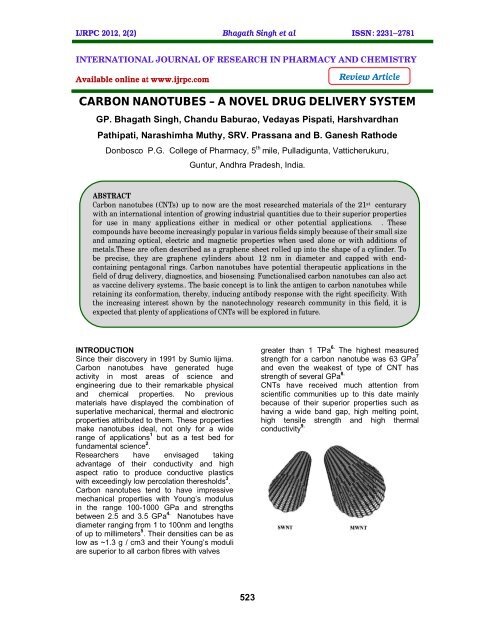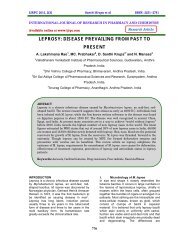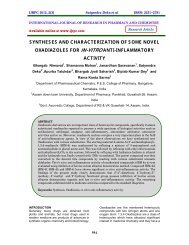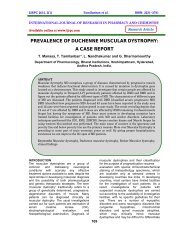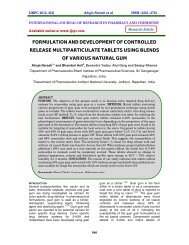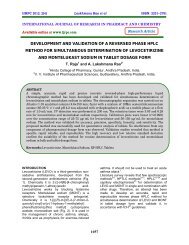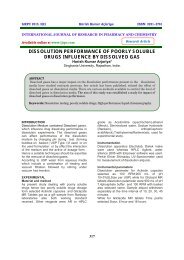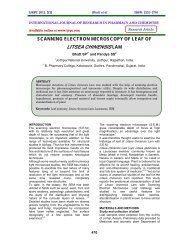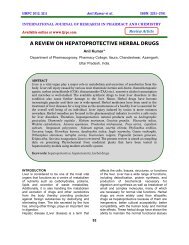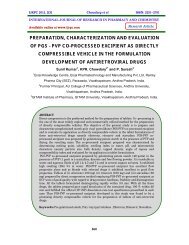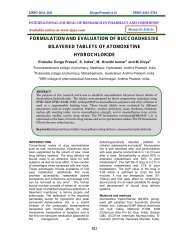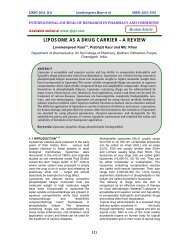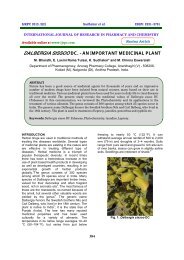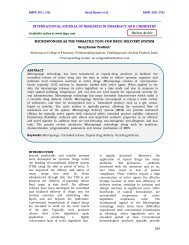CARBON NANOTUBES – A NOVEL DRUG DELIVERY SYSTEM - ijrpc
CARBON NANOTUBES – A NOVEL DRUG DELIVERY SYSTEM - ijrpc
CARBON NANOTUBES – A NOVEL DRUG DELIVERY SYSTEM - ijrpc
You also want an ePaper? Increase the reach of your titles
YUMPU automatically turns print PDFs into web optimized ePapers that Google loves.
IJRPC 2012, 2(2) Bhagath Singh et al ISSN: 22312781<br />
INTERNATIONAL JOURNAL OF RESEARCH IN PHARMACY AND CHEMISTRY<br />
Available online at www.<strong>ijrpc</strong>.com<br />
Review Article<br />
<strong>CARBON</strong> <strong>NANOTUBES</strong> <strong>–</strong> A <strong>NOVEL</strong> <strong>DRUG</strong> <strong>DELIVERY</strong> <strong>SYSTEM</strong><br />
GP. Bhagath Singh, Chandu Baburao, Vedayas Pispati, Harshvardhan<br />
Pathipati, Narashimha Muthy, SRV. Prassana and B. Ganesh Rathode<br />
Donbosco P.G. College of Pharmacy, 5 th mile, Pulladigunta, Vatticherukuru,<br />
Guntur, Andhra Pradesh, India.<br />
ABSTRACT<br />
Carbon nanotubes (CNTs) up to now are the most researched materials of the 21 st centurary<br />
with an international intention of growing industrial quantities due to their superior properties<br />
for use in many applications either in medical or other potential applications. . These<br />
compounds have become increasingly popular in various fields simply because of their small size<br />
and amazing optical, electric and magnetic properties when used alone or with additions of<br />
metals.These are often described as a graphene sheet rolled up into the shape of a cylinder. To<br />
be precise, they are graphene cylinders about 12 nm in diameter and capped with endcontaining<br />
pentagonal rings. Carbon nanotubes have potential therapeutic applications in the<br />
field of drug delivery, diagnostics, and biosensing. Functionalised carbon nanotubes can also act<br />
as vaccine delivery systems.. The basic concept is to link the antigen to carbon nanotubes while<br />
retaining its conformation, thereby, inducing antibody response with the right specificity. With<br />
the increasing interest shown by the nanotechnology research community in this field, it is<br />
expected that plenty of applications of CNTs will be explored in future.<br />
INTRODUCTION<br />
Since their discovery in 1991 by Sumio lijima.<br />
Carbon nanotubes have generated huge<br />
activity in most areas of science and<br />
engineering due to their remarkable physical<br />
and chemical properties. No previous<br />
materials have displayed the combination of<br />
superlative mechanical, thermal and electronic<br />
properties attributed to them. These properties<br />
make nanotubes ideal, not only for a wide<br />
range of applications 1 but as a test bed for<br />
fundamental science 2 .<br />
Researchers have envisaged taking<br />
advantage of their conductivity and high<br />
aspect ratio to produce conductive plastics<br />
with exceedingly low percolation theresholds 3 .<br />
Carbon nanotubes tend to have impressive<br />
mechanical properties with Young’s modulus<br />
in the range 100-1000 GPa and strengths<br />
between 2.5 and 3.5 GPa 4. Nanotubes have<br />
diameter ranging from 1 to 100nm and lengths<br />
of up to millimeters 5 . Their densities can be as<br />
low as ~1.3 g / cm3 and their Young’s moduli<br />
are superior to all carbon fibres with valves<br />
greater than 1 TPa 6. The highest measured<br />
strength for a carbon nanotube was 63 GPa 7<br />
and even the weakest of type of CNT has<br />
strength of several GPa 8.<br />
CNTs have received much attention from<br />
scientific communities up to this date mainly<br />
because of their superior properties such as<br />
having a wide band gap, high melting point,<br />
high tensile strength and high thermal<br />
conductivity 9.<br />
523
IJRPC 2012, 2(2) Bhagath Singh et al ISSN: 22312781<br />
Carbon nanotube<br />
Its (CNTs) attractiveness comes from its<br />
unique physical, chemical, mechanical and<br />
thermal properties originating from the small<br />
size, cylindrical structure, and high aspect ratio<br />
of length to diameter. A single-walled carbon<br />
nanotube (SWCNT) consists of a single<br />
graphene sheet wrapped around to form a<br />
cylinder. A multi-walled carbon nanotube<br />
(MWCNT) is concentrically<br />
nested cylinders of grapheme sheets. CNTs<br />
have extremely high tensile strength (≈150<br />
GPa, more than 100 times that of the stainless<br />
steel), high modulus (≈1 TPa), large aspect<br />
ratio, low density (1100<strong>–</strong>1300 kg/m3, one-sixth<br />
of that of stainless steel), good chemical and<br />
environmental stability, high thermal<br />
conductivity (3000 W/m/K, comparable to<br />
diamond) and high electrical conductivity<br />
(comparable to copper). Carbon nanotubes<br />
have different potential applications, like<br />
electrodes for electrochemical double layer<br />
capacitors 10 , field emitters 11 , nano-electronic<br />
devices<br />
12 , and hydrogen storage 13 , as<br />
functional polymers 14 , etc. Researchers<br />
have also reported making of conductive,<br />
electromagnetic and microwave absorbing and<br />
high-strength composites, fibers, sensors,<br />
inks, energy storage and energy conversion<br />
devices, radiation sources and nanometersized<br />
semiconductor devices, probes, and<br />
interconnect using carbon nanotubes 15-16 .<br />
Recently, strong and stretchable CNT fibers<br />
were spun from 0.65-mm-long CNT forests,<br />
which have the strength and Young’s modulus<br />
of 1.91 GPa and 330 GPa, respectively 16 .<br />
SWCNT/PVA composite fibers are tougher<br />
than any natural or synthetic organic fiber<br />
described so far 17 . Obviously the bulk<br />
production of carbon nanotubes in an<br />
economic way is the route for feasibility of<br />
these applications. CNTs are generally<br />
synthesized by electric arc discharge method,<br />
laser ablation method, catalytic chemical<br />
vapour deposition (CVD), flame synthesis,<br />
solar energy route, etc. 18-19 . The common<br />
feature of arc discharge and laser ablation<br />
methods is the need for high amount of<br />
energy, which is supplied by means of an arc<br />
discharge or laser to induce the reorganization<br />
of carbon atoms into CNTs. The temperature<br />
used is even higher than 3000 ◦C, which is<br />
beneficial for good crystallization of the CNTs,<br />
thus, the products are always produced with<br />
good graphite alignment. However, the basic<br />
requirements of these systems, including<br />
vacuum conditions and continuous graphite<br />
target replacement, pose difficulties to the<br />
large-scale production of CNTs. In contrast<br />
chemical vapour deposition (CVD) has been<br />
proven to be a preferred route for large-scale<br />
production of carbon nanotubes 20-21 . Here the<br />
carbon is deposited from a hydrocarbon (or<br />
other carbon bearing source) in the presence<br />
of a catalyst at temperatures lower than 1200<br />
◦C. The CNT structure, such as its wall<br />
number, diameter, length, and alignment, can<br />
be well controlled during the CVD process.<br />
Thus, the CVD method has the advantages of<br />
mild operation, low cost, and controllable<br />
process, and is the most promising method for<br />
the mass production of CNTs. Various<br />
scalable processes have been reported with<br />
CVD methods, including “Carbon Multiwall<br />
Nanotubes” of Hyperion Company 22 ,<br />
“CoMoCATTM Process at SWCNT” of the<br />
University of Oklahoma 23-24 , “HiPCO Process”<br />
of Rice university 25-26 , and “Nano Agglomerate<br />
Fluidized Bed” process of Tsinghua<br />
University 27-28 . Though the fluidized bed<br />
technique is the most promising route for the<br />
mass production of carbon nanotubes,<br />
fluidization of nano-sized particles is itself a<br />
challenge. The published literature contains<br />
four good reviews 29-30 on the present subject<br />
matter.<br />
Carbon nanotubes have the potential to carry<br />
drugs in the organism as they are hollow and<br />
much smaller than the blood cells. The<br />
methods were developed for attaching DNA<br />
and protein molecules to the inside and<br />
outside of the nanotubes. This gives one the<br />
ability to target and destroy individual cells that<br />
may be cancerous or infected by a virus.<br />
Nanotubes with attached enzymes might, in<br />
the long term, be used as enzymatic<br />
biosensors that could simultaneously detect<br />
and measure a variety of biological<br />
molecules 31 .<br />
524
IJRPC 2012, 2(2) Bhagath Singh et al ISSN: 22312781<br />
TYPES OF CNTs<br />
There are two types of Carbon nanotubes<br />
Single walled carbon nanotubes (SWCNTs)<br />
and Multiwalled carbon nanotubes(MWCNTs).<br />
Differences between SWNT and MWNT<br />
SWNT<br />
Single layer graphene<br />
MWNT<br />
Multiple grapheme layer<br />
Catalyst is required for synthesis<br />
Can be produced without catalyst<br />
Bulk synthesis is difficult as it requires<br />
proper control over growth and atmospheric<br />
Bulk synthesis is easy<br />
conditions.<br />
Purity is poor<br />
Purity is high<br />
A chance of defect is more during<br />
fuictionalization<br />
A chance of defect is less but once<br />
occurred it is difficult to improve<br />
Less accumulation in body<br />
More accumulation in the body<br />
Characterization and evaluation is easy It has very complex structure<br />
It can be easily twisted & are more liable<br />
It cannot be easily twisted<br />
Method of preparation<br />
There are three types of methods generally<br />
used<br />
ARC Discharge method<br />
Laser Ablation method &<br />
CVD ( chemical vapour deposition)<br />
ARC Discharge method<br />
This method is for preparations of large<br />
amounts. This method is used for producing<br />
C60 fullerence, it is the most common and the<br />
easiest way to produce carbon nanotubes.<br />
This technique produces a mixture of<br />
components and requires separating<br />
nantoubes from the sooth and the catalytic<br />
metals present in the crude product.<br />
This is about ARC-vaporization of two carbon<br />
rods placed end to end, separated by<br />
approximately 1mm, in an enclosure filled with<br />
inert gas( helium of argon) at low pressures<br />
i.e. between 50 to 700 mbar. A direct current<br />
of 50 to 100A driven by approximately 20V<br />
creates a high temperature discharge between<br />
two electrodes. The discharge vaporizes one<br />
of the carbon rods and forms a small shaped<br />
deposit on the other rod. 32<br />
Depending on the exact technique it is<br />
possible to selectively grow SWCNTs or<br />
MWCNTs and the typical yield is up to 30 to<br />
90%.<br />
Laser Ablation method<br />
This synthesis was first reported in 1995, by<br />
Smalley’s group at Rice University. A pulsed<br />
or continuous laser is used to vaporize a<br />
graphite target in an oven at 1200 o C . The<br />
main difference between continuous and<br />
pulsed laser is that the pulsed laser demands<br />
a much higher light intensity (100KW/cm 2<br />
compared with 12KW/cm 2 ). The oven is filled<br />
with helium or argon gas in order to keep the<br />
pressure at 500 Tor. A very hot vapour<br />
plume forms then expands and cools rapidly.<br />
As the vaporized species cool, small carbon<br />
molecules and atoms quickly condense to<br />
form larger clusters, possibly including<br />
fullerences. The catalysts also begin to<br />
condense and attach to carbon clusters and<br />
prevent their closing into cage structure.<br />
(Catalysts may even open cage structures<br />
when they attach to them) and the typical yield<br />
is upto 70%.<br />
The SWCNTs formed in this case are bundled<br />
together by Van der walls forces. 32<br />
Chemical vapour deposition (CVD)<br />
It is achieved by putting a carbon source<br />
(methane, carbon monoxide and acetylene) in<br />
the gas phase and using an energy source,<br />
such as plasma or a resistively heated coil, to<br />
transfer energy to a gaseous carbon molecule.<br />
The energy source is used to crack the<br />
molecule into reactive atomic carbon. Then,<br />
the carbon diffuses towards the substrate,<br />
which is heated and coated with a catalyst (Ni,<br />
Fe & CO) where it will bind.<br />
CVD synthesis is a two step process<br />
consisting of a catalyst preparation followed by<br />
the actual synthesis of CNT. The catalyst is<br />
generally prepared by sputtering a transition<br />
metal onto a substrate and then using either<br />
chemical etching or thermal annealing to<br />
induce catalyst particle nucleation. Thermal<br />
annealing results in cluster formation on the<br />
substrate, from which the nantoube will grow.<br />
Ammonia maybe used as the etchant. The<br />
temperature 32 ranges maintained are 650 to<br />
900 o C and the typical yield is 20 to 100%.<br />
Properties of carbon nanotubes<br />
‣ Carbon nanotubes are cylindrical tubes of<br />
nanoscopic dimensions. There are two<br />
types of nanotubes: CNT-SW (singlewalled<br />
nanotubes) and CNT-MW (multiwalled<br />
nanotubes).<br />
‣ Typical diameters range from a few<br />
nanometers (approx. 5 - 30nm, and even<br />
525
IJRPC 2012, 2(2) Bhagath Singh et al ISSN: 22312781<br />
IJRPC 2012, 2(2) Bhagath Singh et al ISSN: 22312781<br />
CNTs in Drug Delivery and Cancer Therapy<br />
Drug delivery is a rapidly growing area that is<br />
now taking advantage of nanotube technology.<br />
Systems being used currently for drug delivery<br />
include dendrimers, polymers, and liposomes,<br />
but carbon nanotubes present the opportunity<br />
to work with effective structures that have high<br />
drug loading capacities and good cell<br />
penetration qualities. These nanotubes<br />
function with a larger inner volume to be used<br />
as the drug container, large aspect ratios for<br />
numerous functionalization attachments, and<br />
the ability to be readily taken up by the cell 38 .<br />
Because of their tube structure, carbon<br />
nanotubes can be made with or without end<br />
caps, meaning that without end caps the<br />
inside where the drug is held would be more<br />
accessible. Right now with carbon nanotube<br />
drug delivery systems, problems arise like the<br />
lack of solubility, clumping occurrences, and<br />
half-life 39 . However, these are all issues that<br />
are currently being addressed and altered for<br />
further advancements in the field of Carbon<br />
nanotubes. The advantages of carbon<br />
nanotubes as nanovectors for drug delivery<br />
remain where cell uptake of these structures<br />
was demonstrated efficiently where the effects<br />
were prominent, showing the particular<br />
nanotubes can be less harmful as<br />
nenovehicles for drugs 40 . Also, drug<br />
encapsulation has been shown to enhance<br />
water dispersibility, better bioavailability, and<br />
reduced toxicity. Encapsulation of molecules<br />
also provides a material storage application as<br />
well as protection and controlled release of<br />
loaded molecules 39 . All of these result in a<br />
good drug delivery basis where further<br />
research and understanding could improve<br />
upon numerous other advancements, like<br />
increased water solubility, decreased toxicity,<br />
sustained half-life, increased cell penetration<br />
and uptake.<br />
Selective cancer cell destruction<br />
Carbon nanotubes can be used as<br />
multifunctional biological transporters and<br />
near-infrared agents for selective cancer cell<br />
destruction 41 . Biological systems are known to<br />
be highly transparent to 700- to 1,100-nm<br />
near-infrared (NIR) light. Researchers showed<br />
that the strong optical absorbance of singlewalled<br />
carbon nanotubes (SWNTs) in this<br />
special spectral window, an intrinsic property<br />
of SWNTs, can be used for optical stimulation<br />
of nanotubes inside living cells to afford<br />
multifunctional nanotube biological<br />
transporters. They used oligonucleotides<br />
transported inside living Hela cells by<br />
nanotubes. The oligonucleotides translocated<br />
into the cell nucleus upon endosomal rupture<br />
triggered by NIR laser pulses. Continuous NIR<br />
radiation caused cell death because of<br />
excessive local heating of SWNT in vitro.<br />
Selective cancer cell destruction was achieved<br />
by functionalization of SWNT with a folate<br />
moiety, selective internalization of SWNTs<br />
inside cells labeled with folate receptor tumor<br />
markers, and NIR-triggered cell death, without<br />
harming receptor-free normal cells. Thus, the<br />
transporting capabilities of carbon nanotubes<br />
combined with suitable functionalization<br />
chemistry and their intrinsic optical properties<br />
can lead to new classes of novel<br />
nanomaterials for drug delivery and cancer<br />
therapy 41 .<br />
Mode of break down of CNTs in the body.<br />
Carbon nanotubes were once considered<br />
biopersistent in that they did not break down in<br />
body tissue or in nature. In recent years,<br />
research has shown that laboratory animals<br />
exposed to carbon nanotubes via inhalation or<br />
through injection into the abdominal cavity<br />
develop severe inflammation. This and the<br />
tissue changes (fibrosis) that exposure causes<br />
lead to impaired lung function and perhaps<br />
even to cancer. For example, a year or two<br />
ago, alarming reports by other scientists<br />
suggested that carbon nanotubes are very<br />
similar to asbestos fibres, which are<br />
themselves biopersistent and which can cause<br />
lung cancer (mesothelioma) in humans a<br />
considerable time after exposure. 42<br />
A team of Swedish and American scientists<br />
has shown for the first time that carbon<br />
nanotubes can be broken down by an enzyme<br />
- Myeloperoxidase (MPO) -- found in white<br />
blood cells. Their discoveries are presented in<br />
Nature Nanotechnology and contradict what<br />
was previously believed, that carbon<br />
nanotubes are not broken down in the body or<br />
in nature. The scientists hope that this new<br />
understanding of how MPO converts carbon<br />
nanotubes into water and carbon dioxide can<br />
be of significance to medicine. 42<br />
This current study thus represents a<br />
breakthrough in nanotechnology and<br />
nanotoxicology, since it clearly shows that<br />
endogenous MPO can break down carbon<br />
nanotubes. This enzyme is expressed in<br />
certain types of white blood cell (neutrophils),<br />
which use it to neutralise harmful bacteria.<br />
Now, however, the researchers have found<br />
that the enzyme also works on carbon<br />
nanotubes, breaking them down into water<br />
and carbon dioxide. The researchers also<br />
showed that carbon nanotubes that have been<br />
broken down by MPO no longer give rise to<br />
inflammation in mice. 42<br />
527
IJRPC 2012, 2(2) Bhagath Singh et al ISSN: 22312781<br />
Medical applications<br />
‣ Nanotubes bound to an antibody that is<br />
produced by chickens have been shown to<br />
be useful in lab tests to destroy breast<br />
cancer tumors. The antibody carrying<br />
nanotubes are attracted to proteins<br />
produced by a one type of breast cancer<br />
cell. Then the nanotubes absorb light from<br />
an infrared laser, incinerating the<br />
nanotube and the tumor they are attached<br />
to. 32<br />
‣ Using nanotubes as a cellular scale<br />
needle to deliver quantum dots and<br />
proteins into cancer cells.- Improve the<br />
healing process for broken bones by<br />
providing a carbon nanotube scaffold for<br />
new bone material to grow on. 32<br />
‣ Combining carbon nanotubes with<br />
biological systems can significantly<br />
improve medical science — especially<br />
diagnostics and disease treatment.<br />
Nothing has been fully developed and<br />
finalized yet, but we see progress every<br />
day.<br />
As an example, we’ll take anti-cancer<br />
treatment. When a patient goes through<br />
regular chemotherapy, he loses hair and<br />
has some other side effects for one reason<br />
— because chemotherapy doesn’t destroy<br />
“bad” cells only. Along with those tumor<br />
cells, it destroys healthy cells too. That’s<br />
why scientists are working so hard to<br />
avoid that. And carbon nanotubes could<br />
make that possible. Scientists from<br />
Stanford University have discovered that<br />
nanotubes, when exposed to infrared light,<br />
tend to heat up to 160°F (70°C) in just 120<br />
seconds. If they are placed inside the<br />
cancer cells, they simply destroy them.<br />
Testings also showed that infrared has no<br />
effects on cell where no nanotubes are<br />
placed. This could lead to development of<br />
a<br />
cancer-killer.<br />
Gene therapy could also be improved by<br />
using carbon nanotubes. Let’s say that a<br />
damaged or missing gene could be<br />
replaced with another one from outside.<br />
But that’s complicated — because DNA<br />
can’t pass through the cell membrane.<br />
What is needed is a transporter, and<br />
modified carbon nanotubes play their role<br />
here. 32<br />
‣ Another application of carbon nanotubes<br />
in medicine is for sensing the molecules or<br />
species. Many studies on the<br />
electrochemical reactivity of carbon<br />
nanotubes showed that carbon nanotubes<br />
can enhance the biomolecules and<br />
promote the electron transfer in proteins. It<br />
has been found that carbon nanotubes<br />
promote electron transfer in heme<br />
containing proteins. In heme containing<br />
proteins carbon nanotubes are able to<br />
access the heme centre of biomolecules<br />
that is generally not sensed by the glass<br />
electrodes.<br />
‣ Carbon nanotubes can also be used as<br />
blood vessels in order to deliver drugs to<br />
their target. When the drug delivery is<br />
done that way, the drug dosage can be<br />
lowered (and it’s cheaper for the<br />
pharmaceutical companies). There are two<br />
methods, both equally effective — a) the<br />
drug can be attached to the side or<br />
behind, b) or the drug can actually be<br />
placed inside the nanotube. 43<br />
‣ Synthetic muscles <strong>–</strong> due to their high<br />
contaraction/extension ratio given an<br />
electric current CNTs are ideal for<br />
synthetic muscle. 44<br />
‣ Artificial muscles- CNTs have sufficient<br />
contractility to make them candidates to<br />
replace muscle tissue. 45<br />
‣ Osteoblastic and proliferation and bone<br />
formation. 46<br />
‣ As the nanotubes function like a needle at<br />
the cellular level. This property is used in<br />
attaching molecules that are attracted to<br />
cancer cells to nanotubes to deliver drugs<br />
directly to diseased cells.<br />
‣ The attachment of ethylene glycol<br />
molecules to nanoparticles of nanotubes<br />
stops WBCs from recognizing the<br />
nanoparticles a s foreign materials ,<br />
allowing them to circulate in the blood<br />
streams long enough to attach to cancer<br />
tumor therapy.<br />
‣ Used to stimulate an immune response to<br />
fight respiratory viruses when inhaled.<br />
‣ To promote blood cell maturation in bone<br />
marrow transplant recipients.<br />
‣ Magnetic fields drive drug loaded<br />
nanoparticles to reduce blood vessel<br />
blockages in an animal study.<br />
‣ Functionalized carbon nanotube as<br />
emerging nanovectors for the delivery of<br />
therapeutics.<br />
‣ Carbon nanotubes as nanomedicines:<br />
from toxicology to pharmacology.<br />
‣ Compressive mechanical properties of<br />
carbon nanaotues encapsulating helical<br />
copper nanowires.<br />
‣ CNTs are being highly used in the fields of<br />
efficient drug delivery and biosensing<br />
methods for disease treatment and health<br />
monitoring. 32<br />
‣ Functionlazation of SWCNTs enhances<br />
solubility and allow for efficient tumor<br />
targeting drug delivery. It prevents SWNTs<br />
528
IJRPC 2012, 2(2) Bhagath Singh et al ISSN: 22312781<br />
from being cytotoxic and altering the<br />
function of immune cells.<br />
‣ CNTs functionalized with lipids are highly<br />
water soluble which would make their<br />
movement through the human body easier<br />
and would also reduce the risk of blockage<br />
of vital body organ pathways thus making<br />
them more attractive as drug delivery<br />
vehicles. 32 CNTs as drug delivery vehicles<br />
have shown potential in targeting specific<br />
cancer cells with a dosage lower than<br />
conventional drugs used(does not harm<br />
healthy cells and significantly reduces side<br />
effects) .32<br />
‣ CNTs can be used as multifunctional<br />
biological transporters and near-infrared<br />
agents for selective cancer cell<br />
destruction.<br />
‣ An aligned CNT with ultra sensitive<br />
biosensor for DNA detection was<br />
developed. 32<br />
Non Medical Applications<br />
Contents<br />
1. Structural<br />
2. Electromagnetic<br />
3. Electoracoustic<br />
4. Chemical<br />
5. Mechanical<br />
1. Structural<br />
They are used for various purposes<br />
Textiles <strong>–</strong> with the help of CNT we can<br />
make waterproof and tear resistant fabrics<br />
Body armor <strong>–</strong> using CNT fibres MIT was<br />
able to stop bullets and monitor the<br />
condition of the wearer. 47<br />
Concrete <strong>–</strong> CNTs in concrete increase the<br />
tensile strength and stops the crack<br />
propagation. 48<br />
Sports equipment <strong>–</strong> Stronger and lighter<br />
tennis rackets , bicycle parts , golf balls ,<br />
golf clubs and baseball bats can be made.<br />
Bridges <strong>–</strong> CNT may be able to replace steel<br />
in suspension.<br />
Fire protection <strong>–</strong> Thin layers of buckypaper<br />
can significantly improve fire resistance due<br />
to the efficient reflection of heat by the<br />
dense, compact layer of CNT or carbon<br />
fibers. 49<br />
Aircraft using carbon nanotubes to increase<br />
strength and flexibility in highly stressed<br />
components. 32<br />
2. Electromagnetic<br />
Optical ignition <strong>–</strong> A layer of 29% iron<br />
enriched single-walled nanotubes (SWNT)<br />
is placed on top of a layer of explosive<br />
material such as PETN, and can be ignited<br />
with a regula camera flash. 50<br />
Superconductor <strong>–</strong> Nanotubes have been<br />
shown to be superconducting at low<br />
temperatures. 51<br />
Ultra capacitors - MIT is researching the<br />
use of nanotubes bound to the charge<br />
plates of capactiors in order to dramatically<br />
increases the surface area and energy<br />
storage ability. 52<br />
Electromagnetic antenna <strong>–</strong> CNTs can act<br />
as antennas for radios and other<br />
electromagnetic devices. 53<br />
3. Electro acoustic<br />
Loudspeaker <strong>–</strong> In November 2008<br />
Tsinghua-Foxconn Nanotechnology<br />
Research Centre in Beijing announced that<br />
it had created loudspeakers from sheets of<br />
parallel CNT, generating sound similar to<br />
how lightening produces thunder. Near<br />
term commercial uses include replacing<br />
piezoelectric speakers in greeting cards. 54<br />
4. Chemical<br />
Desalination <strong>–</strong> water molecules can be<br />
separated from salt by forcing them through<br />
networks of carbon nanotubes, which<br />
require far lower pressures than<br />
conventional reverse osmosis methods. 55<br />
Air pollution filter <strong>–</strong> CNT membranes can<br />
filter carbon dioxide from power plant<br />
emissions.<br />
Hydrogen storage <strong>–</strong> CNT s have the<br />
potential to store between 4.2 and 65%<br />
hydrogen by weight. If they can be mass<br />
produced economically, 13.2 liters (2.9 imp<br />
gal; 3.5 US gal ) of CNT could contain the<br />
same amount of energy as a 50 liters (11<br />
imp gal; 13 US gal) gasoline tank.<br />
5. Mechanical<br />
Oscillator- Oscillators based on CNT have<br />
achieved higher speeds than other<br />
technologies (> 50 GHz).<br />
Infrared detector <strong>–</strong> The reflectivity of the<br />
buckypaper produced with “ super growth”<br />
chemical vapour deposition method is 0.03<br />
or less, potentially enabling performance<br />
gains for pyroelectric infrared detector. 56-57<br />
Thermal radiation <strong>–</strong> For thermal emission in<br />
space such as space satellites.<br />
CONCLUSION<br />
As Carbon nanotubes work beyond our<br />
expectations and their simple mechanism with<br />
long lasting life makes it more reliable to use.<br />
Using it in cancer treatment can guarantee<br />
85% of the cure which other treatments cannot<br />
afford and having 100% site target with its<br />
body friendly nature adds to it advantage. The<br />
versatile properties of CNTs have made them<br />
529
IJRPC 2012, 2(2) Bhagath Singh et al ISSN: 22312781<br />
stand high in all fields, especially in medicine it<br />
has become a boon to the mankind, but the<br />
lack of technology for mass production and the<br />
costs of the production is what is holding them<br />
back. Until now the accumulation of Carbon<br />
nanotubes and its harmfulness has taken pave<br />
among the researchers but not until the<br />
discovery of the enzyme<br />
MPO(Myeloperoxidase) expressed in certain<br />
type of white blood cells (neutrophils) which<br />
can breakdown Carbon Nanotubes into water<br />
and carbon dioxide thus declaring it as bodyfriendly.<br />
REFERENCES<br />
1. Baughman RH, Zakhidov AA, de Heer<br />
WA. Carbon nanotubes— the route<br />
toward applications. Science<br />
2002;297(5582):787<strong>–</strong>92.<br />
2. Cao J, Wang Q, Rolandi M, Dai H.<br />
Aharonov<strong>–</strong>Bohm interference and<br />
beating in single-walled carbonnanotube<br />
interferometers. Phys Rev<br />
Lett 2004;93(21):1<strong>–</strong>4.<br />
3. Kilbride BE, Coleman JN, Fraysse J,<br />
Fournet P, Cadek M, Drury A, et al.<br />
Experimental observation of scaling<br />
laws for alternating current and direct<br />
current conductivity in polymer<strong>–</strong>carbon<br />
nanotube composite thin films. J<br />
Appl Phys 2002;92:4024<strong>–</strong>30.<br />
4. Tibbetts GG, Beetz CP. Mechanicalproperties<br />
of vapor-grown carbonfibers.<br />
J Phys D—Appl Phys<br />
1987;20(3):292<strong>–</strong>7.<br />
5. Hata K, Futaba DN, Mizuno K, Namai<br />
T, Yumura M, Iijima S. Water-assisted<br />
highly efficient synthesis of impurityfree<br />
singlewalled carbon nanotubes.<br />
Science 2004;306(5700):1362<strong>–</strong>4.<br />
6. Wong EW, Sheehan PE, Lieber CM.<br />
Nanobeam mechanics: elasticity,<br />
strength, and toughness of nanorods<br />
and nanotubes. Science<br />
1997;277:1971<strong>–</strong>5.<br />
7. Yu M, Lourie O, Dyer MJ, Kelly TF,<br />
Ruoff RS. Strength and breaking<br />
mechanism of multiwalled carbon<br />
nanotubes under tensile load. Science<br />
2000;287:637<strong>–</strong>40.<br />
8. Xie S, Li W, Pan Z, Chang B, Sun L.<br />
Mechanical and physical properties on<br />
carbon nanotube. J Phys Chem Solids<br />
2000;61(7): 1153<strong>–</strong>8.<br />
9. J. Fischer, in: Y. Gogotsi (Ed.),<br />
Carbon Nanotubes: Structure and<br />
Properties, CR Press, Boca Raton,<br />
2006.<br />
10. J.H. Chen, W.Z. Li, D.Z. Wang, S.X.<br />
Yang, J.G. Wen, Z.F. Ren,<br />
Electrochemical characterization of<br />
carbon nanotubes as electrode in<br />
electrochemical<br />
doublelayer<br />
capacitors, Carbon 40 (2002) 1193<strong>–</strong><br />
1197.<br />
11. J.M. Bonard, H. Kind, T. Stockli, L.O.<br />
Nilsson, Field emission from carbon<br />
nanotubes: the first five years, Solid<br />
State Electron. 45 (2001) 893<strong>–</strong>914.<br />
12. K. Tsukagoshi, N. Yoneya, S. Uryu,<br />
Carbon nanotube devices for<br />
nanoelectronics,Physica B 323 (2002)<br />
107<strong>–</strong>114.<br />
13. A.C. Dillon, K.M. Jones, T.A.<br />
Bekkedahl, C.H. Kiang, D.S. Bethune,<br />
M.J. Heben, Storage of hydrogen in<br />
single-walled carbon nanotubes,<br />
Nature. 1997;386:377<strong>–</strong>379.<br />
14. S.J. Tans, M.H. Devoret, H. Dai, A.<br />
Thess, R.E. Smalley, L.J. Geerligs, et<br />
al., Individual single-wall carbon<br />
nanotubes as quantum wires, Nature<br />
1997;386:474<strong>–</strong>477.<br />
15. R.H. Baughman, A.A. Zakhidov, W.A.<br />
de Heer, Carbon nanotubes <strong>–</strong> the<br />
route toward applications, Science<br />
297 (5582) (2002) 781<strong>–</strong>787.<br />
16. X.F. Zhang, Q.W. Li, Y. Tu, Y. Li, J.Y.<br />
Coulter, L.X. Zheng, Y.H. Zhao, Q.X.<br />
Jia, D.E. Peterson, Y.T. Zhu, Strong<br />
carbon-nanotube fibers spun from<br />
long carbon nanotube arrays, Small 3<br />
(2) (2007) 244<strong>–</strong>248.<br />
17. A.B. Dalton, S. Collins, E. Munoz, J.M.<br />
Razal, V.H. Ebron, J.P. Ferraris, et<br />
al.,Super-tough carbon-nanotube<br />
fibres, Nature 423 (2003) 703<strong>–</strong>1703.<br />
18. T. Guo, C.M. Jin, R.E. Smalley,<br />
Catalytic growth of single-walled<br />
nanotubes by laser vaporization,<br />
Chem. Phys. Lett. 243 (1995) 49<strong>–</strong>54.<br />
19. R.L. Vander Wal, T.M. Ticich, V.E.<br />
Curtis, Diffusion flame synthesis of<br />
singlewalled carbon nanotubes,<br />
Chem. Phys. Lett. 323 (2000) 217<strong>–</strong><br />
223.<br />
20. R. Andrews, D. Jacques, A.M. Rao,<br />
Continuous production of aligned<br />
carbon nanotubes: a step closer to<br />
commercial realization, Chem. Phys.<br />
Lett. 303 (1999) 467<strong>–</strong>474.<br />
21. M. Kumar, Y. Ando, Single-wall and<br />
multiwall carbon nanotubes from<br />
camphor a botanical hydrocarbon,<br />
Diamond Relat. Mater. 12 (2003)<br />
1845<strong>–</strong>1850.<br />
22. Hyperion Catalysis Int’l. Inc., Carbon<br />
fibrils, method for producing same and<br />
compositions, U.S. Patent, 1987 34<br />
4,663,230 6/12/1984.<br />
530
IJRPC 2012, 2(2) Bhagath Singh et al ISSN: 22312781<br />
23. D.E. Resasco, B. Kitiyanan, W.E.<br />
Alvarez, L. Balzano, Process and<br />
apparatus for producing single-walled<br />
carbon nanotubes, US Patent, 2005<br />
6,919,064.<br />
24. B. Kitiyanan, W.E. Alvarez, J.H.<br />
Harwell, D.E. Resasco, Controlled<br />
production of single-wall carbon<br />
nanotubes by catalytic decomposition<br />
of CO on bimetallic Co<strong>–</strong>Mo catalysts,<br />
Chem. Phys. Lett. 317 (3<strong>–</strong>5) (2000)<br />
497<strong>–</strong>503.<br />
25. Rice University, Method of making<br />
ropes of single-wall carbon nanotubes,<br />
US Patent, 2001 No. 6,183,714<br />
26/07/1996.<br />
26. P. Nikolaev, Gas-phase production of<br />
single-walled carbon nanotubes from<br />
carbon monoxide: a review of the<br />
HiPco process, J. Nanosci.<br />
Nanotechnol. 4 (4) (2004) 307<strong>–</strong>316.<br />
27. Y. Wang, F. Wei, G.H. Luo, H. Yu,<br />
G.S. Gu, The large-scale production of<br />
carbon nanotubes in a nanoagglomerate<br />
fluidized-bed reactor,<br />
Chem. Phys. Lett. 364 (5<strong>–</strong>6) (2002)<br />
568<strong>–</strong>572.<br />
28. F. Wei, Y. Wang, G. Luo, H. Yu, Z. Li,<br />
W. Qian, et al., Continuous mass<br />
production of carbon nanotubes in a<br />
nano-agglomerate fluidized-bed and<br />
the reactor, US Patent, 2009 No.<br />
7,563, 427 29/01/2002.<br />
29. R. Philippe, A. Morancais, M. Corrias,<br />
B. Caussat, Y. Kihn, P. Kalck, et al.,<br />
Catalytic production of carbon<br />
nanotubes by fluidized-bed CVD,<br />
Chem. Vapor.Deposit. 13 (2007) 447<strong>–</strong><br />
457.<br />
30. K.J. MacKenzie, O.M. Dunens, A.T.<br />
Harris, An updated review of synthesis<br />
parameters and growth mechanisms<br />
for carbon nanotubes in fluidized<br />
beds,Ind. Eng. Chem. Res. 49 (2010)<br />
5323<strong>–</strong>5338.<br />
31. http://www.ecmjournal.org/journal/sup<br />
plements/vol003supp02/pdf/v003supp<br />
02a29.pdf)<br />
32. Textbook of Engineering Chemistry-II<br />
, by PARSHVA publishers private<br />
limited, Authours- Dr.Srinivasulu<br />
Doddaga, Dr.Ashima Srivastava,<br />
Dr.Roli Verma. of the page<br />
102,103,104.<br />
33. http://www.understandingnano.com/na<br />
notubes-carbon.html<br />
34. C. Srinivasan, “Carbon nanotubes in<br />
cancer therapy” Current Science 94,<br />
300 (2008).<br />
35. T. A. Hilder, J. M. Hill, “Carbon<br />
nanotubes as drug delivery<br />
nanocapsules” Current Applied<br />
Physics 8, 258 (2008).<br />
36. M. Metzger, G. Leibowitz, J.<br />
Wainstein, B. Glaser, I. Raz,<br />
“Reproducibility of glucose<br />
measurements using the glucose<br />
sensor” Diabetes Care 25, 1185<br />
(2002).<br />
37. J. Clendenin, J. Kim, S. Tung, “An<br />
Aligned Carbon Nanotube Biosensor<br />
for DNA Detection” Proc of 2007 2nd<br />
IEEE conference on Nanotechnology,<br />
1028 (2007).<br />
38. Hilder, TA, and JM Hill. "Modeling the<br />
Loading and Unloading of Drugs into<br />
Nanotubes." Small 5, 300-08 (2009).<br />
39. Pastorin, G. "Crucial<br />
Functionalizations of Carbon<br />
Nanotubes for Improved Drug<br />
Delivery: A Valuable Option?"<br />
Pharmaceutical Research 26, 746-69<br />
(2008).<br />
40. Bhirde, AA, V. Patel, J. Gavard, GF<br />
Zhang, AA Sousa, A. Masedunskas,<br />
RD Leapman, R. Weigert, JS Gutkind,<br />
and JF Rusling. "Targeted Killing of<br />
Cancer Cells in Vivo and in Vitro with<br />
EGF-Directed Carbon Nanotube-<br />
Based Drug Delivery." ACS Nano 3,<br />
307-16 (2009).<br />
41. N. W. S. Kam, M. O’Connell, J. A.<br />
Wisdom, H. Dai, “Carbon nanotubes<br />
as multifunctional biological<br />
transporters and near-infrared agents<br />
for selective cancer cell destruction”<br />
PNAS 102, 11600 (2005).<br />
42. http://www.sciencedaily.com/releases/<br />
2010/04/100405092028.htm<br />
43. http://www.nanomedicinecenter.com/a<br />
rticle/medical-applications-of-carbonnanotubes/)<br />
44. "Giant-Stroke, Superelastic Carbon<br />
Nanotube Aerogel Muscles - Aliev et<br />
al. 323 (5921): 1575 - Science".<br />
Sciencemag.org. 2009-03-20.<br />
doi:10.1126/science.1168312.<br />
Retrieved 2010-02-26.)<br />
45. Methanol-powered artificial muscles<br />
start to flex - tech - 16 March 2006 -<br />
New Scientist Tech<br />
46. Haddon, Robert C.; Laura P. Zanello,<br />
Bin Zhao, Hui Hu (16). "Bone Cell<br />
Proliferation on Carbon Nanotubes".<br />
Nano Letters 6 (3): 562<strong>–</strong>567. Bibcode<br />
2006NanoL...6..562Z.doi:10.1021/nl05<br />
1861e.PMID 16522063. Retrieved 4<br />
November 2010.)<br />
531
IJRPC 2012, 2(2) Bhagath Singh et al ISSN: 22312781<br />
47. "MIT Institute For Soldier<br />
Nanotechnologies". Web.mit.edu.<br />
Retrieved 2010-02-26.<br />
48. A. G. Nasibulin et al. "A novel<br />
cement-based hybrid material" New J.<br />
Phys. 11 023013 (2009) free<br />
download<br />
49. Z. Zhao and J. Gou "Improved fire<br />
retardancy of thermoset composites<br />
modified with carbon nanofibers" Sci.<br />
Technol. Adv. Mater. 10 (2009)<br />
015005 free download<br />
50. S. A. Tseng et al. "Ignition of carbon<br />
nanotubes using a photoflash" Carbon<br />
45 (2007) 958<br />
51. Z.K. Tang et al. Science 292 (2001)<br />
2462<br />
52. The Ultra Battery, February 13, 2006<br />
53. The World's Smallest Radio: A Single<br />
Carbon Nanotube Can Function As A<br />
Radio That Detects And Plays Songs<br />
54. "Nanotubes turn on the tunes".<br />
Nature. 2008-11-03. Retrieved 2008-<br />
11-07.<br />
55. http://www.sciencedaily.com/releases/<br />
2011/03/110314140632.htm New<br />
desalination process developed using<br />
carbon nanotubes<br />
56. AIST nanotech 2009 K. Mizuno et al.<br />
(2009). "A black body absorber from<br />
vertically aligned single-walled carbon<br />
nanotubes". Proceedings of the<br />
National Academy of Sciences 106<br />
(15): 6044<strong>–</strong>6077. Bibcode<br />
2009PNAS..106.6044M.doi:10.1073/p<br />
nas.0900155106. 2669394.<br />
PMID 19339498<br />
532


